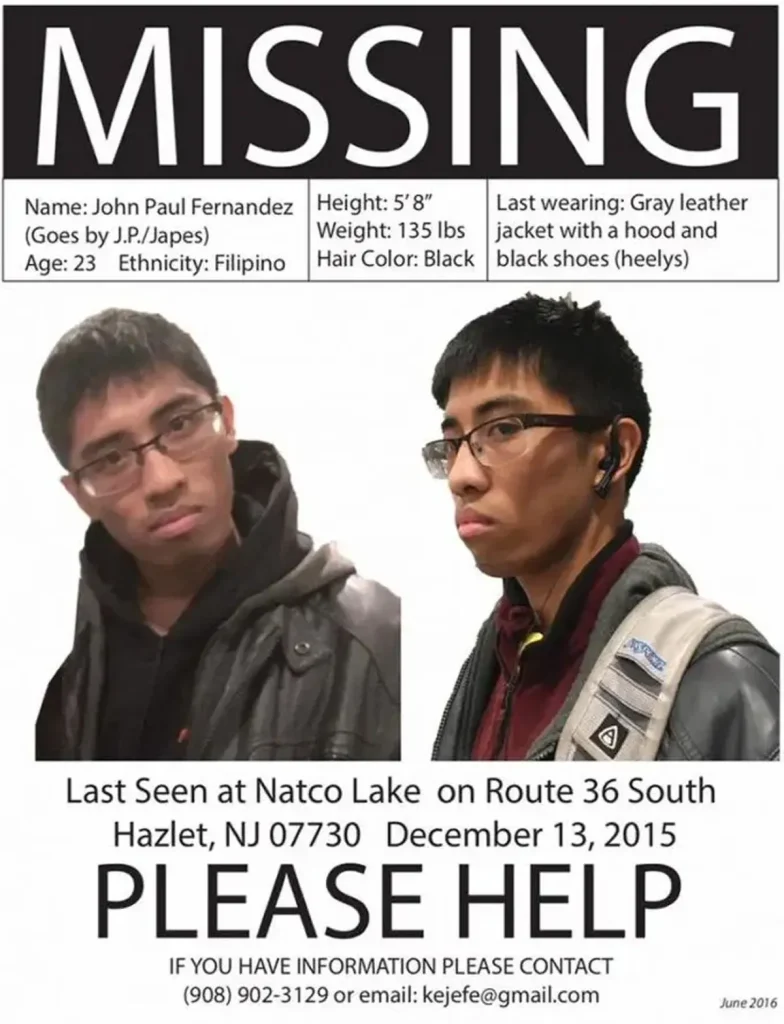Nearly a Decade After He Vanished, Remains Found Near a New Jersey Bike Trail Identified as Missing College Student — Bringing His Family Long-Awaited Closure
For nearly ten years, the family of John Paul Fernandez lived in painful uncertainty — a slow, quiet ache marked by birthdays uncelebrated, holidays half-lived, and prayers that somehow, someday, they would learn what happened to their son. That day has finally come, and though it arrived with heartbreak, it also brought something his mother, Ninia Fernandez, calls “the first real peace we’ve known in years.”

Authorities in Monmouth County, New Jersey, confirmed that human remains found in November 2024 along a wooded section of the Henry Hudson Bike Trail in Middletown have been identified as those of John Paul Fernandez, a college student who disappeared in December 2015. The announcement closes one of the region’s most haunting missing-persons cases — one that baffled investigators, tormented a family, and captivated a community that never stopped hoping for answers.
John Paul was just 23 years old when he vanished. A senior at Seton Hall University studying accounting, he was described by his professors as intelligent and meticulous, with a dry sense of humor and a love of numbers. To his family, he was kind, thoughtful, and deeply attached to his loved ones. On December 13, 2015, he was last seen near his Middletown home in the early morning hours. His phone was later discovered near Natco Lake Park in Hazlet, a few miles from the bike trail where his remains would later be found. Despite extensive searches involving police, volunteers, and cadaver dogs, no trace of him surfaced for years.
The Monmouth County Prosecutor’s Office confirmed that the remains were located off Willow Street, a quiet residential dead end running parallel to the bike trail. Forensic experts used DNA testing to make a positive identification in late 2025, confirming what his family had both dreaded and needed to know.
“There are no words to describe the pain and the countless tears we have cried for him every single day for every year he was gone,” his mother, Ninia, said in a statement shared publicly. “While this brings heartbreaking closure, it also brings peace to finally bring our son home.”
Her words, filled with both anguish and grace, resonated with the thousands who had followed the case since 2015. Through years of online campaigns, missing-person posters, and community searches, John Paul’s story had become one of those tragic reminders of how fragile life can be — and how enduring a family’s love truly is.

Ninia described her son as “quirky, funny, and full of life,” someone who could make anyone laugh with his animated stories and boundless energy. She remembered his gentle heart and the way he always “stepped up when needed.” Her tribute painted the picture of a young man full of promise — the kind of person whose disappearance leaves a visible hole in the lives of everyone who knew him.
For the Fernandez family, the decade-long ordeal was marked by a constant push and pull between hope and despair. They worked tirelessly with police, local search groups, and private investigators, clinging to any lead that might offer a breakthrough. Flyers featuring John Paul’s photo — his short dark hair, glasses, and serious expression — remained tacked to community boards long after most would have given up.
Even when time passed and attention faded, his mother never stopped posting updates, birthday messages, and pleas for information. Each post carried the same unwavering message: “We will never stop looking.”
The discovery of the remains came unexpectedly last fall, when a passerby noticed what appeared to be skeletal remains near the wooded trail. Law enforcement quickly secured the area and began a forensic investigation. For months, the remains remained unidentified, though speculation spread through the community. It wasn’t until October 2025 that testing conclusively matched the DNA to John Paul.
Authorities have not determined an exact cause of death, but early reports indicate no signs of foul play. Officials described the area where his remains were found as secluded and heavily wooded, making discovery unlikely without deliberate searching.
For those who knew John Paul, the news brought both shock and relief. Former classmates and friends at Seton Hall University, where he had been just months away from graduation, expressed sadness but also gratitude that his family could finally have answers. “He was quiet but brilliant,” one classmate said. “He was the kind of person who’d stay late to help you study or crack a joke when you were stressed. It’s devastating that this is how his story ends.”
The Monmouth County community responded with an outpouring of support. Local vigils are being planned, and tributes have flooded social media from friends, neighbors, and even strangers who followed the case over the years. “It’s tragic,” one commenter wrote. “But I hope his family can finally rest knowing he’s been found.”
For Ninia and her family, the years between 2015 and 2025 were filled with quiet rituals of remembrance. They kept John Paul’s room intact for years, a small time capsule of his life before everything stopped. His favorite hoodie remained draped over a chair, his college notes neatly stacked, his photo framed in the living room. “It was how we kept him close,” she said. “Every time I passed his door, I prayed I’d hear him come home.”
Now, that room may finally become a place of peace rather than pain. The family plans to hold a private funeral service followed by a public celebration of his life. “We want people to remember him for who he was,” his mother said. “Not for how he was lost.”
Experts say cases like John Paul’s highlight the persistence of grief for families of missing persons — and the complicated emotions that come even when closure arrives. “When someone disappears, families are left in a suspended state,” says forensic psychologist Dr. Laura Mendoza. “Even when remains are found, closure doesn’t mean the pain disappears. It simply transforms — from searching to remembering.”
The Henry Hudson Bike Trail, once a place of mystery and quiet sorrow, now holds deeper meaning. For the Fernandez family, it’s a site that represents both loss and recovery. The community has discussed the possibility of installing a memorial plaque or bench in John Paul’s name near the area where he was found, as a symbol of remembrance and resilience.
As news of the identification spread, support poured in from across the state. Former volunteers who joined search parties in 2015 and 2016 expressed bittersweet relief that the case had finally come to an end. “We prayed for this day,” said one volunteer. “We always said that even if it wasn’t the answer we wanted, we hoped the family would know where he was.”
While many questions remain — how he ended up there, what exactly happened on that December night — the most important one has finally been answered. The boy who vanished has been found.
In her final message to supporters, Ninia wrote: “Thank you to everyone who never stopped caring. Thank you for your prayers, your time, your love, and your belief that we would find him. We finally have our answer. We finally have our son back.”
For nearly a decade, the story of John Paul Fernandez was one of mystery. Now, it is one of remembrance — a testament to a mother’s strength, a community’s compassion, and the enduring power of love to carry people through even the darkest chapters.
And though the trail in Middletown may grow quiet again, one family’s voice will remain — whispering gratitude, heartbreak, and the peace of finally knowing that their boy has come home.


